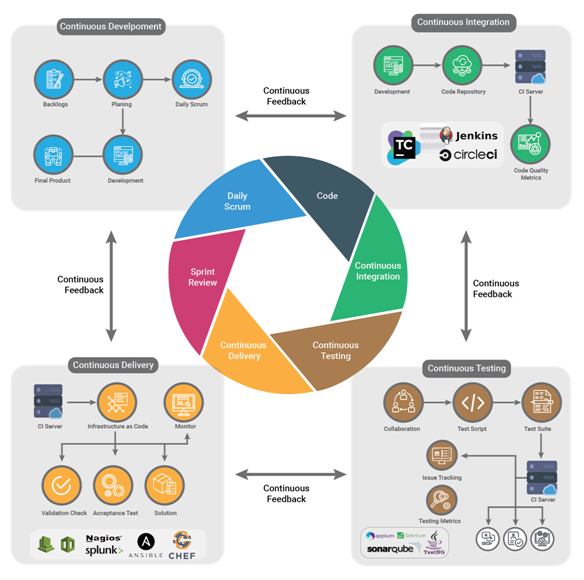DevOps Best Practices
This blog will address such questions and explain DevOps best practices that can help a business realize its true potential.
Join the DZone community and get the full member experience.
Join For FreeTraditional IT had two separate teams in any organization – the development team and the operations team. The development team works on the software, developing and releasing it after ensuring that the code works perfectly. The Operations team works on deployment, load balancing, and release management to make SaaS live.
They check the application performance and report back any issues, if existent to the development team. These cycles went too long for companies and stimulated a need to build a team of mixed expertise of development, QA, and Operations, introducing the phenomenon of DevOps. DevOps bridges the gap between two teams and helps them operate and evolve applications quickly and reliably.
The question is, how well do we really know DevOps and why do we need it? This blog will address such questions and explain DevOps best practices that can help a business realize its true potential.
What Is DevOps?
As the name sounds, Devops is related to development and operations. It defines a set of processes that brings a cultural shift to an organization by developing collaboration between the development and operations team. It has four key components: collaboration, practices, culture, and tools.
Why Do We Need DevOps?
DevOps brings the next level of collaboration and speed that enables organizations to deliver with improved time to market, enhanced productivity, reduced operational cost to serve customers efficiently, and stay competitive in the market. It also helps in faster product release, manage unplanned work, capture and solve the critical issues quicker.
Implementing DevOps Best Practices

Setup Centralized Unit
DevOps uses various tools like Jenkins, Terraform, Nagios, Grafana, Prometheus, or Splunk. The organization should set-up a centralized unit for the creation and operation of these tools. This centralized unit is responsible for set-up agile practices in the development team. This team investigates new tools, upholds it, and provides guidance programs and training to implement DevOps.
Continuous Integration (CI)
CI is a software development practice that improves collaboration amongst the team and helps to build high-quality software. The Development team regularly check-in code changes in the repository, CI executes automated builds and tests to validate the quality of code. Continuous Integration imposes practices that enable quick detection of challenges of the Software Development Life Cycle (SDLC) at an early stage which helps the development team to solve issues in the development phase itself.
Continuous Deployment (CD)
The deployment process has various stages like Development → Build → Validation → Build versioning → Deployment → Post-deployment, etc. The idea of the Continuous Deployment process is to deploy developed code automatically to the production environment after build passes all stages of QA-staging-beta, Integration, UAT, etc. There are tools available like Spinnaker, Jenkins, Harness, Ansible, Chef, Puppet, etc. which enables the DevOps team to set-up automated pipelines to deploy on several environments with minimum human intervention.
Continuous Delivery is a DevOps practice where a new codebase gets tested by a QA team on different stages of automated and manual QA cycles. If the codebase passes the QA cycle and is approved by the QA team, it gets deployed to production. This is how DevOps enables the team to build, test, and release codebase quicker and frequently by dividing it into short cycles. This enables organizations to provide more releases, reduce manual deployments, and minimize failure risk in production.
Configuration Management (CM)
Configuration and Change Management are important parts of the DevOps cycle. Configuration Management is the automation of configuration, monitoring, managing, and maintenance of all entities of infrastructure and systems like servers, applications, storage, networks, and all managed services.
Configuration management brings in several advantages like simplifying new environment setup, reducing production configuration risks, and saves a lot of time for software development instead of investing time and efforts for initiating new services from scratch using Infrastructure-as-a-Code practice.
Change Management
Change management is a process of requesting, planning, implementing, and evaluating the changes that are needed to meet new requirements. During the configuration management, if there are any changes required in the existing system and infrastructure, at that time change management comes into the picture. Operations teams need to provide their inputs, reasons for change, and consequences might arise on a wider level including other systems that could be impacted with new changes.
Keep All Teams on the Same Page
DevOps works with different departments so communication is important. And it’s important to keep everyone on the same page to avoid conflicts in teams. To apply the strategy correctly, higher involvement and adoption is vital to keep all teams and members on the same page.
Test Automation
Automated testing of each codebase helps in running more tests, increases testing frequency, and saves time that is spent on manual QA. This process enables early bug detections, bug-fixing, and enhances overall software quality. There are several tools available which can integrate with DevOps tools like Selenium, RobotFramework, Appium, XCUITest, JUnit, etc. for test automation.
Continuous Monitoring (CM)
Continuous Monitoring suggests to monitor all systems and infrastructure using several tools, dashboards, and alerts including real-time insights of different metrics impacting the software like system performance, number of tests, success and failure rates, deployment status, error logs, and all information in graphical, tabular and detailed report format. To accomplish such monitoring DevOps team can set up several tools like Prometheus, Grafana, Nagios, Appdynamics, NewRelic, Splunk, Logstash and many more are available in the market.
Opinions expressed by DZone contributors are their own.

Comments